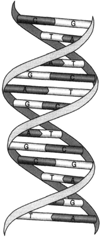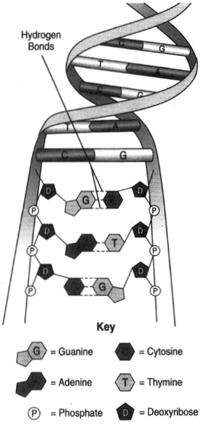The Structure of DNA
 |
| Figure 6-5 The double helix of the DNA molecule: two spirals of alternating sugars and phosphates are bonded together by pairs of bases. |
In Cambridge, England in 1953 James D. Watson and F.H.C. Crick went to work with paper, paste, tin snips, and metal, seeking to construct a three dimensional model of DNA. They took into account all information that had been gathered by other researchers. Of particular importance was Maurice Wilkins’ x-ray diffraction studies of DNA, which indicated a large spiral. The model constructed by Watson and Crick consisted of a double helix: two strands of alternating sugars and phosphates twisted around each other, the strands bonded to each other by pairs of bases. Recall that there are four kinds of bases in DNA-adenine, thymine, cytosine, and guanine-and that these bases are of two sorts-purines and pyrimidines. Chemical analysis had revealed that the amounts of adenine and thymine were always equal, and the amounts of guanine and cytosine were also always equal. Furthermore, the pairs of bases that linked the two helices together always measured the same distance. It was also known, however, that the sizes of purines and pyrimidines differed. Thus, if two purines were linked with each other and two pyrimidines were linked with each other, equal distances between the helices could not be achieved; if, however, a purine were always linked to a pyrimidine, the lengths of the bonding pairs would always be the same. The Watson-Crick model provided for this.
The Watson-Crick model provided for this. It later came to light that adenine, a purine, links only with thymine, a pyrimidine, and that guanine, a purine, links only with cytosine, a pyrimidine. These nitrogenous bases make their connections by weak hydrogen bonds.
The secret of heredity, then, had been unveiled. Learning the structure of this “most golden of all molecules” (James Watson’s words) and the role it plays in heredity is considered one of the greatest discoveries in chemistry. For their efforts, Watson and Crick were awarded the Nobel prize in 1962.
 |
| Figure 6-6 Another representation of the double helix. Here, the five-sided figure represents the 5carbon sugar deoxyribose; the circles represent phosphate groups; and the two chains are bonded by pairs of bases (adeninew ith thymine, guanine with cytosine). New nucleotides may be joined together in the process of replication. |
The DNA in all the cells of a given organism as well as all kinds of organisms appears to be the same: two helices of alternating sugars and phosphates bonded by pairs of bases,. the pairs being of two sorts only (that is, adenine with thymine or cytosine with guanine). It is somewhat bewildering that this apparently simple structure controls the heredity of such diverse forms as plants and human beings. Hundreds of thousands of nucleotides may be joined to form a single nucleic acid molecule. The lengthof DNA in a plant cell is hundreds of thousands of times greater than the diameter of the cell, and a single cell mayc ontain in its genes an amount of information that would cover several hundred thousand pages in a printed form.
The only way that any DNA molecule differs from any other is in the sequencing of the bases along the helix (although the pairing of bases adenine always with thymine, and cytosine always with guanine can be reversed, that is, thymine with adenine and guanine with cytosine). If the number of base pairs alongth e line is very hight,h e number of combinations of adenine, cytosine, guanine, and thymine (ACGT) can be in the hundreds of millions. There are approximately five thousand base pairs in a simple virus; in other organisms, the number of pairs may be in the millions. The variation in cells of different plants is great. A gymnosperm, for example, may have ten thousand fold more base pairs than does another plant species such as Arabidopsis thalliana. It should be noted, however, that a high number of base pairs does not necessarily mean more genetic activity: large segments of DNA are repetitive and do not do anything.




